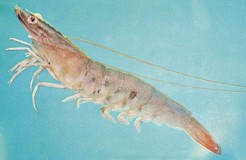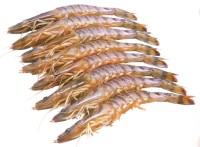Shrimp
http://www.100md.com
《e Natural Health Center》
 |
 |
 |
 |
Seafood
Shrimp
Latin:
Caridina Serrata
Origin:
Shrimp belongs to any of the approximately 2,000 species of the suborder Natantia (order Decapoda of the class Crustacea). Close relatives include crabs, crayfish, and lobsters. Common species include Neocaridina sp., Natania gen sp., Caridina Serrata, Caridina Japonica, Atyopsis Moluccensis, Atyopsis Spinipes, etc.
, http://www.100md.com
Shrimps are characterized by a semitransparent body flattened from side to side and a flexible abdomen terminating in a fanlike tail. The appendages are modified for swimming, and the antennae are long and whiplike.
Shrimps occur in all oceans--in shallow and deep water--and in freshwater lakes and streams. Many species are commercially important as food. Shrimps range in length from a few millimetres to more than 20 centimetres; average size is about 4 to 8 cm. Larger species are often called prawns.
, http://www.100md.com
Shrimps swim backward by rapidly flexing the abdomen and tail. Food consists of small plants and animals; some shrimps feed on carrion. The female shrimp may lay from 1,500 to 14,000 eggs, which are attached to the swimming legs. The larvae pass through five developmental stages before becoming mature.
Shrimp have ten legs and long antennae. Though they spawn in deep offshore waters, but young shrimp swim into shallow waters where they develop into adults. Their habitats range from Alaska to South America, Taiwan to Australia. With their firm yet succulent pale-pink flesh, shrimps are the most popular seafood around the world. They provide the basis for an enormous fishery and a growing shrimp-farming business.
, http://www.100md.com
Shrimp can be sold raw with heads and shells intact; raw with shells on and heads removed; raw and peeled; or peeled, cooked, and deveined. They are sold by the "count," which is the number of shrimp per 454 g. Shrimp can be frozen individually (called IQF), or in blocks. Most shrimp sold in U.S. supermarkets and fish markets have been frozen and thawed. Shrimp are also available canned.
There are thousands of varieties of shrimp, but those we eat fit into two categories.
, 百拇医药
Warm-water shrimp: These tend to be medium to large in size. Those named for the color of their shells include white shrimp, pink shrimp, and brown shrimp--they all have pink meat when cooked. Rock shrimp have sweet meat within shells that are difficult to peel. Freshwater shrimp (or Malaysian prawns) come from lakes and river deltas in Asia and can grow to weigh nearly 454 g.
Cold-water shrimp: These tend to be smaller, but have firmer, sweeter meat. Pacific ocean pink and Atlantic Northern pink shrimp are usually machine-peeled, cooked, and served as shrimp meat. Spot, sidestrip, and coon shrimp live in North Atlantic waters and are usually sold fresh.
, http://www.100md.com
Most varieties of shrimp are available year-round.
Properties:
Sweet and salty in flavor, slightly warm in nature, it is related to the channels of the liver and kidney.
Functions:
Tones kidneys, strengthens yang (male energy), promotes milk secretion, draws out poison, is anti-stress and nerve calming.
, 百拇医药
Applications:
Shrimp is used for impotence, shortage of milk secretion, erysipelas (acute febrile disease associated with local inflammation of the skin), carbuncle, ecthyma (skin eruption that consists of large pustules).
1. For impotence, seminal emission, frequent or uncontrolable urination due to deficiency of the kidneys:
Stir fry shrimps with Chinese chive. Add salt as seasoning.
, 百拇医药
2. For lack of milk secretion after childbirth:
Consume stir-fried shrimps with rice liquor or pork trotter soup.
3. For weakness, unerrupted measles:
Grind cooked shrimps into powder and consume it.
Dosage and Administration:
Wash shrimp and pat dry with a paper towel.
, 百拇医药 Shrimp can be cooked with heads and shells on, or peeled. Cooking shrimp in their shells seals in flavor and juices, but then they must be peeled by diners at the table, a messy job you may want to avoid. If you prefer to cook them peeled, twist off the heads, then, running your finger along the abdomen, lift off the shells.
Shrimp have edible sand veins, actually digestive sacs, that run along their backs. Most smaller shrimp are only peeled, but larger shrimp look more attractive deveined. If you wish to devein a peeled shrimp, run a sharp knife along the vein, then rinse under cold water to remove the vein and any grit. To devein a shrimp with the shell on, cut through the shell along the vein, then lift the vein out with a toothpick.
, http://www.100md.com
Brining shrimp removes excess water and gives shrimp a crunchy texture. To brine shrimp, dissolve salt and sugar in hot water. Add a tray of ice cubes and stir. Place shrimp in the cold solution and soak 30 minutes for peeled shrimp, or 60 minutes for shrimp with shells on.
Shrimp cook very quickly and toughen with heat. The secret to successful shrimp cookery is to not overcook them. Cook shrimp at the last minute and serve them hot.
, http://www.100md.com
Pan frying: Rinse shrimp and pat dry with paper towels. Heat a frying pan until hot and add oil. Add shrimp, making sure they are not crowded in the pan, and fry, turning occasionally, for 4 to 8 minutes, depending on size. Shrimp are done when they are opaque in the center.
Deep frying: Pour oil into a wok or deep fryer; it should be at least 3.8 cm deep, and the cooker should be less than half full of oil. Heat oil to 190° C, using a thermometer to monitor temperature. Dip peeled shrimp in batter, drain, then slip them into hot oil. Cook until brown, 2 to 3 minutes.
, 百拇医药
Simmering: Pour enough cooking liquid (water or broth and herbs or spices) in pan to cover shrimp. Bring to a boil, add shrimp, and reduce heat. Simmer until shrimp are opaque in the center, 3 to 6 minutes, depending on size and whether or not they have been peeled.
Grilling: If shrimp are small, string them on a skewer, then place them 10 cm above prepared hot coals or fire. Cook until opaque and moist on the inside, 3 to 4 minutes.
, 百拇医药
Broiling: Place aluminum foil on a baking pan and spread shrimp on top. Place 10 cm from the heat and broil 2 minutes on each side.
Because most shrimp have been frozen and deteriorate quickly after they've thawed, they stay fresher if you buy them still frozen.
When purchasing thawed shrimp, be sure that they smell fresh, without the slightest hint of ammonia. Shrimp should have unstained shells, with no black spots along the sides, a condition called melanosis.
, 百拇医药
Some shrimps have been dipped in sodium bisulfite or sodium tripolyphosphate to improve appearance and extend shelf life. If you are concerned about these additives, ask your fish seller to show you the box the shrimp were received in.
To store thawed shrimp, unwrap, place them in a bowl covered with a wet paper towel, refrigerate, and prepare and eat them the same day. Frozen shrimp can be stored in its original wrappings in the freezer for up to two months. Take out and use shrimp as you need them, then reseal the bag and return it to the freezer.
, 百拇医药
To thaw, unwrap, place shrimp in a bowl or pan, cover, and let thaw overnight in the refrigerator. To more quickly, wrap shrimp in waterproof plastic and place them in a sink with cool running water, allowing about 1/2 hour per 454 g. For fastest thawing, use the defrost cycle of your microwave, allowing 2 to 5 minutes per 454 g, with equal standing time in between zaps.
Cautions on Use:
Reference Materials:
, http://www.100md.com
Toxic or Side Effects:
Modern Researches:
Shrimp contains protein, fat, calcium, phosphorus, iron, vitamins A, B1, and is rich in sodium and cholesterol but low in fiber. Shrimp is a rich source of iodine, and a good source of selenium (33.7 mcg), and vitamin B12 (1.3 mcg).
When cooked (moist heat), shrimp (mixed species) provides 0.327 grams of omega-3 fatty acids, derived from EPA (0.171 g), DHA (0.144 g), and ALA (0.012 g), per 100 grams of shrimp (mixed species)., http://www.100md.com